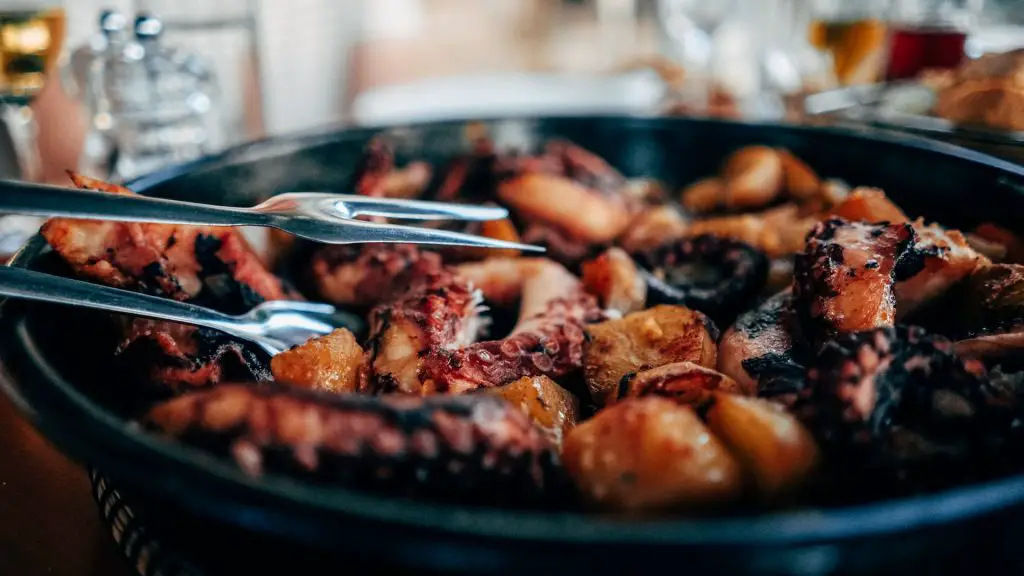Croatia, nestled in the heart of Europe along the Adriatic Sea, is a country that boasts not only breathtaking natural beauty but also a rich and diverse culinary heritage. Its traditional foods are a reflection of its history, culture, and geography. In this article, we will take a deep dive into the world of Croatian cuisine, exploring its traditional dishes, ingredients, and the unique flavors that make it a gastronomic paradise.
A Taste of Croatia’s Geography
Croatia’s diverse geography plays a pivotal role in shaping its traditional food. The country is divided into several regions, each with its own distinct culinary identity. From the coastal regions along the Adriatic Sea to the fertile plains of Slavonia, let’s take a gastronomic journey through Croatia’s unique terroir.
Coastal Delights: Dalmatia and Istria
Dalmatia and Istria, the coastal regions of Croatia, are renowned for their seafood-based cuisine. The crystal-clear waters of the Adriatic Sea provide a bountiful supply of fish and seafood, making these areas a seafood lover’s paradise.
Dalmatian Peka:
One of the most iconic dishes of Dalmatia is the Peka. It consists of a combination of meats, typically lamb or veal, and vegetables slow-cooked under a bell-like lid. The result is a tender and flavorful dish that captures the essence of the Mediterranean.
Black Risotto:
Istria is famous for its Black Risotto, known locally as “Crni Rižot.” The striking black color comes from squid ink, which is mixed with rice, seafood, and aromatic spices. It’s a unique and delicious dish that leaves a lasting impression.
Dalmatian Seafood Platter:
When in Dalmatia, don’t miss the opportunity to indulge in a seafood platter featuring a variety of freshly caught fish, shellfish, and squid. Grilled to perfection and served with olive oil and Mediterranean herbs, it’s a culinary delight.
Continental Charms: Zagorje and Slavonia
Moving inland, the continental regions of Croatia offer a different culinary experience, with an emphasis on hearty and comforting dishes.
Zagorski Štrukli:
Zagorski Štrukli is a beloved dish from the Zagorje region. It consists of thin layers of dough filled with cottage cheese, sour cream, and eggs. Baked to perfection, it’s a delightful blend of textures and flavors.
Paprikaš and Čobanac:
Slavonia is known for its Paprikaš and Čobanac dishes, both of which feature generous amounts of paprika. Paprikaš is typically made with chicken or veal, while Čobanac features various meats, often slow-cooked in a rich paprika-infused sauce.
Strudel and Krempita:
For dessert, you can’t go wrong with a slice of apple or cherry strudel, followed by a creamy slice of Krempita, a custard-filled pastry that’s a true comfort food.
The Mediterranean Influence
Croatia’s location along the Mediterranean has had a significant impact on its culinary traditions. Olive oil, wine, and an abundance of fresh herbs are staples in Croatian kitchens, giving their dishes a Mediterranean flair.
Croatian Olive Oil:
Croatian olive oil is highly regarded for its quality and flavor. The Istrian and Dalmatian regions are particularly famous for their olive groves, producing some of the finest olive oils in the world.
Croatian Wine:
Croatia has a long history of winemaking, with numerous indigenous grape varieties. Be sure to try some Plavac Mali, Graševina, or Malvazija wine to complement your Croatian meal.
Herbs and Spices:
Mediterranean herbs like rosemary, oregano, and bay leaves are commonly used to season dishes, infusing them with aromatic flavors.
Festival of Flavors: Croatian Festivals and Traditions
Croatia’s rich culinary heritage is celebrated throughout the year in various festivals and traditions. These events provide a perfect opportunity to immerse yourself in the country’s food culture.
Tastes of Zagreb:
This annual food festival in Zagreb showcases the diversity of Croatian cuisine. Visitors can savor a wide range of traditional dishes, from street food to gourmet delights.
Štruklijada:
The town of Zagorje hosts the Štruklijada festival, dedicated to the beloved dish Zagorski Štrukli. Here, you can taste different variations of this delicacy and even participate in a Štrukli-making competition.
Truffle Hunting:
In Istria, truffle hunting is a tradition that allows you to experience the thrill of searching for these coveted fungi with the help of trained truffle-hunting dogs. Afterwards, you can enjoy truffle-infused dishes.
Preserving Tradition: Slow Food Movement in Croatia
Croatia has embraced the Slow Food movement, which emphasizes the importance of preserving traditional foods, local ingredients, and sustainable agriculture. This movement has led to the revival of many traditional dishes and the protection of indigenous ingredients.
Bringing Croatia to Your Kitchen
If you’re inspired to bring a taste of Croatia to your own kitchen, here are a few traditional recipes to try:
Recipe 1: Dalmatian Peka
Ingredients:
1 kg of mixed meat (lamb, veal, chicken)
Assorted vegetables (potatoes, bell peppers, tomatoes, onions)
Olive oil
Rosemary, thyme, and bay leaves
Salt and pepper
Instructions:
Arrange the meat and vegetables in a large baking dish.
Drizzle generously with olive oil and season with salt, pepper, and herbs.
Cover with a bell-like lid or aluminum foil.
Bake in a preheated oven at a low temperature (around 150°C or 300°F) for several hours until the meat is tender and the flavors have melded together.
Recipe 2: Black Risotto (Crni Rižot)
Ingredients:
300g Arborio rice
500g squid, cleaned and chopped
1 onion, finely chopped
2 cloves garlic, minced
2-3 tablespoons olive oil
2-3 tablespoons squid ink
1 glass of white wine
Fish or vegetable stock
Salt and pepper
Parsley for garnish
Instructions:
In a large pan, sauté the onion and garlic in olive oil until translucent.
Add the rice and cook for a few minutes until it becomes translucent.
Pour in the white wine and stir until it’s absorbed.
Start adding the squid ink, a little at a time, and continue stirring.
Gradually add the stock, stirring constantly, until the rice is cooked and creamy.
Add the chopped squid and cook for a few more minutes until they are tender.
Season with salt and pepper and garnish with chopped parsley before serving.
Croatia’s traditional food is a delightful reflection of its geography, history, and cultural diversity. From the seafood-rich dishes of the coast to the hearty meals of the continental regions, Croatia offers a wide range of culinary experiences. Whether you have the opportunity to visit this beautiful country or try your hand at Croatian recipes in your own kitchen, you’re sure to discover the unique and delicious flavors that make Croatian cuisine truly special. So, savor the taste of Croatia and enjoy the journey through its gastronomic wonders.
With its diverse culinary traditions and unique flavors, Croatia’s traditional food is a true delight for food enthusiasts. Whether you’re visiting Croatia or trying out Croatian recipes at home, there’s no doubt that the country’s rich culinary heritage will leave you craving for more.
Regional Variations and Unique Specialties
While we’ve explored some of Croatia’s most iconic dishes and culinary traditions, it’s important to note that each region within the country has its own unique specialties and variations. Let’s take a closer look at some of these regional delights:
Kvarner Bay and Škampi na Buzaru:
Along the Kvarner Bay, you’ll find the delectable dish of Škampi na Buzaru, featuring large Adriatic prawns cooked in a tomato and wine sauce infused with garlic, parsley, and a touch of chili. It’s a flavorful masterpiece that captures the essence of the sea.
Lika and Peka with Octopus:
In the rugged region of Lika, Peka takes on a unique twist with octopus as the star ingredient. Slow-cooked with potatoes and herbs, it’s a testament to the resourcefulness of Croatian cuisine.
Kvarner and Krk Island’s Pršut:
Krk Island in the Kvarner region is famous for its Pršut, a dry-cured ham similar to Italian prosciutto. Sliced thinly and served with local cheese and olives, it’s a perfect appetizer.
Baranja and Fiš Paprikaš:
The Baranja region in the east of Croatia is known for Fiš Paprikaš, a spicy fish stew made with freshwater fish, paprika, and hot peppers. It’s a hearty and warming dish enjoyed especially in the colder months.
Dalmatian Soparnik:
Soparnik is a traditional Dalmatian pastry filled with a mixture of Swiss chard, garlic, and olive oil. It’s a beloved dish in the coastal areas, often enjoyed at local celebrations and gatherings.
The Influence of History and Neighboring Cultures
Croatia’s history is marked by various influences from neighboring countries and empires, including the Roman Empire, the Venetian Republic, the Ottoman Empire, and the Austro-Hungarian Empire. These historical connections have left a lasting impact on Croatian cuisine.
Italian Influences:
The proximity to Italy is evident in dishes like pasta, risotto, and the use of olive oil and herbs. Croatian seafood dishes, such as scampi and calamari, often feature Italian-inspired recipes.
Austro-Hungarian Heritage:
The Austro-Hungarian influence can be seen in dishes like Štrukli, which resemble Austrian strudels. The use of paprika and spices in Croatian cuisine also reflects Hungarian culinary traditions.
Turkish and Ottoman Influence:
From the Ottoman Empire, Croatia inherited dishes like čevapi, a type of grilled minced meat, and various pastries filled with nuts and honey.
Culinary Traditions and Celebrations
Croatia’s culinary traditions are deeply intertwined with its celebrations and festivals. Here are a few more noteworthy culinary events:
Christmas and Easter Feasts:
During Christmas and Easter, Croatian families come together to prepare lavish feasts. Traditional dishes like baked lamb, ham, and a variety of desserts, including potica (nut roll) and pinca (Easter bread), are enjoyed during these festivities.
Fritule and Krostule:
Fritule and Krostule are popular Croatian sweets enjoyed during carnival season. These deep-fried doughnuts and pastries are often dusted with powdered sugar and are a delight for both children and adults.
Fešta od Sira:
In the town of Pag, on Pag Island, the “Fešta od Sira” (Cheese Festival) celebrates the island’s famous Pag cheese. Visitors can taste various cheese varieties and experience the unique cheese-making traditions of the region.
The Future of Croatian Cuisine
As Croatia continues to gain recognition for its culinary heritage, chefs and food enthusiasts are exploring innovative ways to blend tradition with modernity. The country’s commitment to sustainable and locally sourced ingredients is also driving a culinary renaissance.
Croatia’s traditional food is a true reflection of its diverse history, geographical beauty, and cultural richness. From the seafood feasts of the Adriatic coast to the hearty dishes of the continental regions, Croatian cuisine offers a delightful journey for your taste buds.
Whether you have the opportunity to explore Croatia’s culinary treasures firsthand or try your hand at traditional recipes in your own kitchen, you’ll undoubtedly be captivated by the flavors and stories that make Croatian cuisine a culinary gem in the heart of Europe. So, embark on this gastronomic adventure and savor the tastes of Croatia – a country where tradition meets innovation on every plate.




